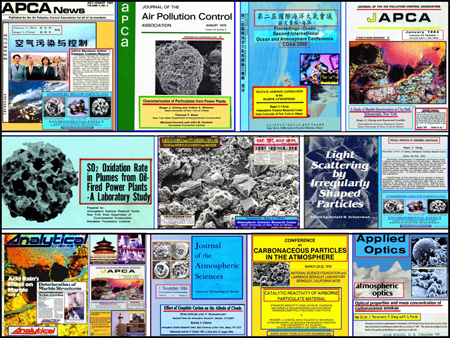
|
||||
|
|
.jpg) |
|
|
 |
|||||
|
ROGER
J. CHENG
ATMOSPHERIC SCIENCE RESEARCH
CENTER
STATE UNIVERSITY of NEW YORK at ALBANY JIH-RU HWU
DEPT. of CHEMISTRY
The JOHNS HOPKINS UNIVERSITY
Industrial particulates and sub-microcrystals of sulfates have been positively identified from field samples of acid precipitations (cloud, fog and rain droplets). Laboratory experiments confirmed that gaseous S0/2 absorbed by water droplets when contaminated by a few fine particulates of flyash from coal combustion, could be converted to sulfuric acid. The oxidation rate of H2/S03 to H2/S04 in aqueous solutions was investigated under three different conditions via titrimetric and turbidimetric methods. The resulting turbidity was determined by a UV-spectrophotometer (420 nm) and compared to a curve prepared from standard sulfate solution. Without flyash present in a solution of H2/S03 only 8% of [S0/4] is generated after 24 hours. In the presence of flyash obtained from a coal-fired power plant, the conversion Increases to 13%. However, a much large effect appears when flyash from oil-fired power plant exist. The conversion reaches 32% and is four times that of the system without flyash. The oxidation is a fast process and most [S0/3] changes to [S0/4] in 3-4 hours. Formation of acid precipitations in the atmosphere has been suggested primarily as a result of the oxidation of S0/2 by photochemical processes in the gas phase and by homogeneous reaction in solution. But these mechanisms cannot explain the observed high concentration of sulfates in the atmosphere. It is hypothesized here that the formation of acid precipitation in the atmosphere is also due to heterogeneous reaction of catalytic S0/2 oxidation on the surface of industrial particulates inside cloud droplets. Heterogeneous catalysts, such as carbon, vanadium, manganese and iron associated with the surface of particulates generated by electric power plants burning fossil fuels (especially coal); contribute to the complex surface chemical interactions which result in the formation of acid droplets and sulfate crystals. Characterization of industrial particulates and sulfate aerosols from field samples collected from ASRC Whiteface Mountain Research Station in the Adirondack region of New York State, the chemical processes of catalytic S0/2 oxidation inside microscopic droplets and the effect of acid precipitation on our environment are presented with illustrations.
|
|
BEIJING (PEKING).
CHINA NOVEMBER 7-12, 1982
|
||||
|
||||
|
|
|||||||||||
|
 |
.jpg) |
|
ACID RAIN'S EFFECT on MARBLE STRUCTURES |
 |
|
|
 |
 |
    |
||||||||||

|
 |
||||||||||||||||||||
|
||||||||||||||||||||
|
 
|
|
|
NECROTIC INJURED LEAF by POWER PLANT EMISSIONS Roger J. CHENG-郑均华: ASRC SUNYUNIVERSITY at ALBANY, UALBANY
|
|
 
 |
|
|
|

 |

|
|---|

The MICRO-WORLD in the ATMOSPHERE |
||||||||||||||||||||||||||||||||||||||||||||||||||||||||||||
|
ENVIRONMENTAL SCIENCES PROJECT 纽约州立大学,大气科学研究中心 郑均华研究员主持的科研项目 |
||||||||||||||||||||||||||||||||||||||||||||||||||||||||||||
|
REFERENCES
-
|
||||||||||||||||||||||||||||||||||||||||||||||||||||||||||||
| Roger J. CHENG-ASRC-UALBANY | ||||||||||||||||||||||||||||||||||||||||||||||||||||||||||||
|
||||||||||||||||||||||||||||||||||||||||||||||||||||||||||||

|








































.jpg)









.jpg)